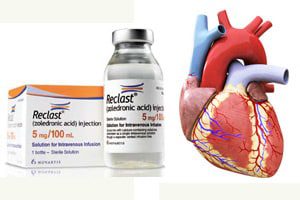
New research has found that bisphosphonate use was tied to a significant increased risk of both atrial fibrillation (AF) and serious AF. Bisphosphonates include Fosamax (alendronate sodium), Reclast and Zometa (zoledronic acid), Boniva (ibandronate sodium), Didronel (etidronate disodium), Actonel (risedronate sodium), and Skelid (tiludronae disodium). In a systematic review of randomized controlled and observational studies, […]
 New research has found that bisphosphonate use was tied to a significant increased risk of both atrial fibrillation (AF) and serious AF. Bisphosphonates include Fosamax (alendronate sodium), Reclast and Zometa (zoledronic acid), Boniva (ibandronate sodium), Didronel (etidronate disodium), Actonel (risedronate sodium), and Skelid (tiludronae disodium).
New research has found that bisphosphonate use was tied to a significant increased risk of both atrial fibrillation (AF) and serious AF. Bisphosphonates include Fosamax (alendronate sodium), Reclast and Zometa (zoledronic acid), Boniva (ibandronate sodium), Didronel (etidronate disodium), Actonel (risedronate sodium), and Skelid (tiludronae disodium).
In a systematic review of randomized controlled and observational studies, researchers found that bisphosphonate use was tied to a 27 percent increased risk of AF in the observational studies and a 40 percent increased risk in randomized controlled studies, Abhishek Sharma, MD, of Maimonides Medical Center in Brooklyn, New York, and colleagues found, according to MedPage Today. The results appear in the October issue of the journal Chest.
Previous studies have revealed a similar trend, but the data were not viewed as significant at the time. The drugs, which are used in the treatment and prevention of osteoporosis, have been linked to increased risks for atypical femur fractures, MedPage Today wrote.
The research included six observational studies with 149,856 participants and six randomized controlled trials with 41,375 total participants. The observational studies revealed that oral bisphosphonate use increased serious risk of AF in patients with no prior AF history, but with a fracture history. Patients with cancer who received bisphosphonates intravenously with no history of AF experienced increased AF risk when compared with cancer patients without drug exposure who were age-, sex-, and cancer type-matched, according to MedPage Today.
According to the study’s authors, the non-oral administration of bisphosphonates can “activate an inflammatory cascade and alter the expression of proteins that handle intracellular calcium” and increased arrhythmia risk, MedPage Today reported.
We’ve long been following risks associated with bisphosphonate drugs like Fosamax, Boniva, and Actonel, approved to treat bone-weakening diseases like osteoporosis and Paget’s disease. Cancer patients also often undergo therapy with Aredia, Zometa, and other bisphosphonate drugs to prevent fractures from bone metastases.
Prior research revealed that risks for developing osteonecrosis of the jaw (ONJ) following dental extractions raises significantly in patients taking bisphosphonates and the risks dramatically increases if the drugs were received intravenously, according to the study published in the International Journal of Oral and Maxillofacial Surgery. We also wrote that dental extractions appear to be a major trigger for ONJ in people receiving bisphosphonates to treat multiple myeloma or Waldenstrom’s macroglobulinemia, according to an Italian study published in the Blood Cancer Journal. All of the patients involved in that study received either Zometa or Aredia.
In 2005, the U.S. Food & Drug Administration (FDA) ordered that warnings about ONJ be added to labels for Fosamax and other bisphosphonates. It is believed that osteonecrosis may develop when bisphosphonates prevent the body from repairing microscopic damage to the jawbone, such as what is seen during routine dental procedures. Also, in October 2010, the FDA asked that manufacturers of bisphosphonates approved for the treatment of osteoporosis include information to the “Warnings and Precautions” section of the drugs’ labels that describes the risk of atypical thigh fractures after research linked long-term use of these drugs to that particular side effect. And, recent studies revealed that long-term use of oral bisphosphonates may increase risks for patients developing esophageal cancer.


